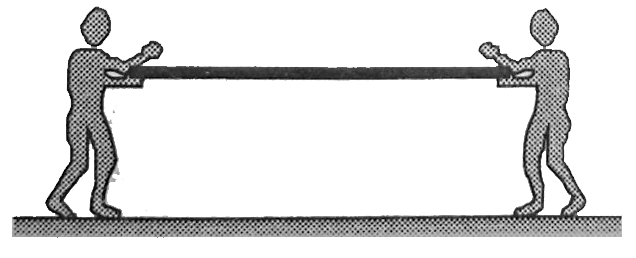According to Newton's third law each team pulls the opposite team with equal force in a tug of war. Why then one team wins aned the other loses?
Step by step video & image solution for According to Newton's third law each team pulls the opposite team with equal force in a tug of war. Why then one team wins aned the other loses? by Physics experts to help you in doubts & scoring excellent marks in Class 11 exams.
Updated on:21/07/2023Topper's Solved these Questions
- NEWTON'S LAWS OF MOTIONBOOK - HC VERMA ENGLISHCHAPTER - NEWTON'S LAWS OF MOTIONEXERCISE - Exercises
42 Videos
- LAWS OF THERMODYNAMICSBOOK - HC VERMA ENGLISHCHAPTER - LAWS OF THERMODYNAMICSEXERCISE - All Questions
64 Videos
- PHYSICS AND MATHEMATICSBOOK - HC VERMA ENGLISHCHAPTER - PHYSICS AND MATHEMATICSEXERCISE - Question for short Answer
14 Videos
Similar Questions
(A) : According to Newton's third law sum of action and reaction is not equal to zero
(r) : The forces action and reaction acts on different bodies
View SolutionA : According to Newton's third law of motion for every action, there is an equal and opposite reaction.
R : There is no time lag between action and reaction.
View SolutionIn a tug of war, the team that exerts a larger tangential foce on the ground wins. Consider the period in which a team is dragging the opposite team by applying a larger tangential force on the ground. Which of the following works are negative ?
View SolutionAccording to the third law of motion, when we push on an object, the object pushes back on us with an equal and opposite force. If the object is a massive truck parked along the roadside, it will probably not move. A student justifies this by answering that the two opposite and equal forces cancel each other. Comment on this logic and explain why the truck does not move.
View Solution
Two persons pull each other through a massless rope in tugofwar game. Who will win?
View SolutionAccording to Newton's law of gravitation each particle attracts every other particle. But we do not see bodies on the surface of the earth moving towards each other. Why?
View SolutionIn the next world cup of cricket there will be 12 teams, divided equally in two groups. Teams of each group will play a match against each other. From each group 3 top teams will qualify for the next round.In this round each team will play against other once. Each of the four top teams of this round will play amatch against the other three. Two top teams of this round will go to the final round, where they will playthe best of three matches. The minimum number of matches in the next world cup will be
View SolutionIn a tug of war competition, two men pull the ends of the rope with forces equal in magnitude and opposite in direction. What is the tension in the rope ?
View SolutionCollision is a physical process in which two or more objects, either particle masses or rigid bodies, experience very high force of interaction for a very small duration. It is not essential for the objects to physically touch each other for collision to occur. Irrespective of the nature of interactive force and the nature of colliding bodies, Newton's second law holds good on the system. Hence, momentum of the system before and after the collision remains conserved if no appreciable external force acts on the system during collision.
The amount of energy loss during collision, if at all, is indeed dependent on the nature of colliding objects. The energy loss is observed to be maximum when objects stick together after collision. The terminology is to define collision as 'elastic' if no energy loss takes place and to define collision as 'plastic' for maximum energy loss. The behaviour of system after collision depends on the position of colliding objects as well. A unidirectional motion of colliding objects before collision can turn into two dimensional after collision if the line joining the centre of mass of the two colliding objects is not parallel to the direction of velocity of each particle before collision. Such type of collision is referred to as oblique collision which may be either two or three dimensional.
According to the definition of collision in paragraph I, which of the following physical process is not a collision?
View SolutionCollision is a physical process in which two or more objects, either particle masses or rigid bodies, experience very high force of interaction for a very small duration. It is not essential for the objects to physically touch each other for collision to occur. Irrespective of the nature of interactive force and the nature of colliding bodies, Newton's second law holds good on the system. Hence, momentum of the system before and after the collision remains conserved if no appreciable external force acts on the system during collision.
The amount of energy loss during collision, if at all, is indeed dependent on the nature of colliding objects. The energy loss is observed to be maximum when objects stick together after collision. The terminology is to define collision as 'elastic' if no energy loss takes place and to define collision as 'plastic' for maximum energy loss. The behaviour of system after collision depends on the position of colliding objects as well. A unidirectional motion of colliding objects before collision can turn into two dimensional after collision if the line joining the centre of mass of the two colliding objects is not parallel to the direction of velocity of each particle before collision. Such type of collision is referred to as oblique collision which may be either two or three dimensional.
According to the definition of oblique collision in the paragraph, which of the following collisions cannot be oblique'?
View Solution
